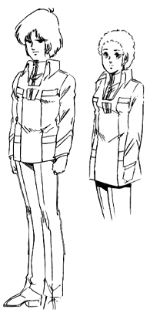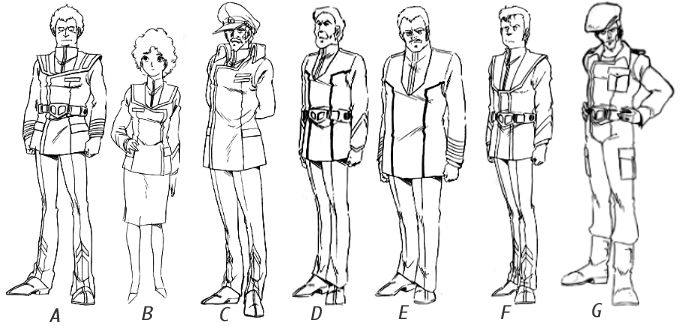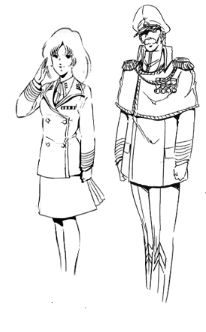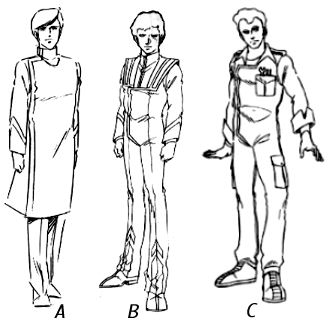

History of the uniforms (not yet written)
While the UNDF retained the field uniforms of the militaries of the UN member states, a common semi-dress uniform was adopted in 2001, that consisted of a shirt, and color-matched slacks and a pull-over smock. The design used by the UNDF would ultimately yield the famous semi-dress uniform of the RDF, when the UN was disestablished after the conclusion of the Unification War.

Above: UNDF semi-dress uniform
The basic RDF semi-dress uniform consisted of a pair of slacks (with a skirt optional for female soldiers), a shirt, and a jacket. The color of the jacket indicated a soldier's branch and department, and the color of the shirt would indicate department and unit. Slacks were color-coded with the shirt, and skirts color-coded with the jacket. An outer belt was worn outside the jacket. Military Police, from all branches, were issued a distinctive jacket that immediately identified the wearer as law enforcement. Similarly, flag officers (including Colonels and "flag Captains" - or Captain, upper) wore a jacket with a distinctive collar befitting their rank.
The RDF duty uniform, rarely worn outside the army, replaced the jacket with a pull-over smock that could be optionally fastened with an external belt. Aside from the collar, this uniform was closest to the UNDF semi-dress uniform that had preceeded it.
The RDF fatigues were a more simple matter. Essentially a BDU jumpsuit, the fatigues were worn with a t-shirt and exterior belt, and formed the basis of the standard duty uniform for most enlisted men, and most officers in the field. The fatiues were manufactured in a number of color schemes; blue (for Spacy and Air Force personnel), yellow (for flight crew and engineers), urban camo, woodland, 6-color desert khaki, and tiger stripe among them.

A: Standard RDF semi-dress uniform, male officer.
B: Standard RDF semi-dress uniform, female enlisted.
C: Standard RDF semi-dress uniform, flag officer (0-7 and above).
D: Standard RDF duty uniform, enlisted man.
E: Standard RDF duty uniform, officer.
F: RDF Military Police uniform
G: RDF military fatigues
The RDF Dress uniform was a simple matter for flag-officers. It consisted of a short wrap including shoulder epaulets that was worn over the semi-dress jacket. The uniform for all other ranks was a seperate shirt and double-breasted jacket, though the semi-dress slacks and skirt were retained in the dress uniform. Aside from the traditional difference in which side of the jacket opened, male and female dress jackets were identical.

Left: Standard RDF Dress uniform, officer and enlisted.
Right: Standard RDF Dress uniform, flag officer (O-7 and above)
In addition to the above, some specialized uniforms existed in the RDF. Among them was a doctor's smock, a jumpsuit variant of the semi-dress slacks and jacket, and a light jumpsuit based on a pattern similar to that of the standard fatigues, usually used by technitians and engineers in hot climates and hot engine rooms.

A: RDF Medical smock.
B: RDF semi-dress work jumpsuit.
C: RDF work jumpsuit.
Pay Grade |
Rank |
Abbreviation |
Collar |
Chest |
Chest |
Chest |
Chest |
Chest |
|---|---|---|---|---|---|---|---|---|
| O-1 | Third Lieutenant | 3LT |  |
 |
 |
 |
 |
|
| O-2 | Second Lieutenant | 2LT |  |
 |
 |
 |
 |
|
| O-3 | First Lieutenant | 1LT |  |
 |
 |
 |
 |
|
| O-4 | Lieutenant Commander | LCDR |  |
 |
 |
 |
 |
|
| O-5 | Commander | CDR |  |
 |
 |
 |
 |
|
| O-6 | Captain Major * |
CAPT MAJ |
 |
 |
 |
 |
 |
|
| O-7 | Flag Captain Colonel * |
FCAPT COL |
 |
 |
 |
 |
 |
|
| O-8 | Rear Admiral Major General * |
RADM MAJGEN |
 |
 |
 |
 |
 |
|
| O-9 | Vice Admiral Lieutenant General * |
VADM LTGEN |
 |
 |
 |
 |
 |
|
| O-10 | Admiral General * |
ADM GEN |
 |
 |
 |
 |
 |
|
| O-11 | Fleet Admiral ***
General of the Army General of the Air Force |
FADM
GEN |
 |
 |
 |
NONE |
 |
 |
 Using cues from the show I devised (or perhaps more accurately, catalogued) a Navy/Spacy scheme that contained ranks specifically mentioned in "The Macross Saga" (3LT, 2LT, 1LT/CAPT, LCDR, CDR, CAPT, ADM), and for some time this was accepted. Peter Walker then began to investigate the possibility that the RDF was the controlling entity for the SC. When it was determined that this was the case, a unified rank structure seemed appropriate. Problems were encountered because of the existence of the rank of "Major," as seen in "Southern Cross." Peter has argued that (with the ship's sheer size as evidence) that Major Carpenter's command required an O-Grade befitting the commander of a large vessel. I disagree (Carpenter could be the X.O. or the senior officer still alive after the long journey to Earth), but concede that it is a valid theory.
Using cues from the show I devised (or perhaps more accurately, catalogued) a Navy/Spacy scheme that contained ranks specifically mentioned in "The Macross Saga" (3LT, 2LT, 1LT/CAPT, LCDR, CDR, CAPT, ADM), and for some time this was accepted. Peter Walker then began to investigate the possibility that the RDF was the controlling entity for the SC. When it was determined that this was the case, a unified rank structure seemed appropriate. Problems were encountered because of the existence of the rank of "Major," as seen in "Southern Cross." Peter has argued that (with the ship's sheer size as evidence) that Major Carpenter's command required an O-Grade befitting the commander of a large vessel. I disagree (Carpenter could be the X.O. or the senior officer still alive after the long journey to Earth), but concede that it is a valid theory.
 Assuming Carpenter is not the ship's original C.O., we would have the following structure:
Assuming Carpenter is not the ship's original C.O., we would have the following structure:
| O-1 | O-2 | O-3 | O-4 | O-5 | O-6 | O-7 to O-11 | Service | 3LT | 2LT | 1LT | LCDR | CDR | CAPT | Admiral Ranks | Navy/Spacy | 2LT | 1LT | CAPT | MAJ | LTCOL | COL | General Ranks | Army/AF/Marines |
 This is the structure I used for some time and was modified more than once. However, Peter felt that Carpenter's ship warranted a commander of higher rank. I proposed that Carpenter might have been a junior officer, but this suggestion was rejected. I devised a rank structure to deal with Carpenter's rank, assuming he is the ship's X.O. or something less than its Commanding Officer. I simply moved all the Army ranks up one notch by adding a 3LT for the O-1.
This is the structure I used for some time and was modified more than once. However, Peter felt that Carpenter's ship warranted a commander of higher rank. I proposed that Carpenter might have been a junior officer, but this suggestion was rejected. I devised a rank structure to deal with Carpenter's rank, assuming he is the ship's X.O. or something less than its Commanding Officer. I simply moved all the Army ranks up one notch by adding a 3LT for the O-1.
| O-1 | O-2 | O-3 | O-4 | O-5 | O-6 | O-7 | O-8 to O-12 | Service | 3LT | 2LT | 1LT | LCDR | CDR | CAPT (l.) | CAPT | Admiral Ranks | Navy/Spacy | 3LT | 2LT | 1LT | CAPT | MAJ | LTCOL | COL | General Ranks | Army/AF/Marines |
 Adding this rank into the Army/AF/Marine scheme required the addition of a rank in the Navy/Spacy structure to balance things out. I argued against the elimination of a flag rank to avoid the problems associated with rank compression, and Peter placated me by agreeing that the rank of Captain (lower) should be used instead of Commodore to balance out the ranks between the Army/AF structure and the Navy structure.
Adding this rank into the Army/AF/Marine scheme required the addition of a rank in the Navy/Spacy structure to balance things out. I argued against the elimination of a flag rank to avoid the problems associated with rank compression, and Peter placated me by agreeing that the rank of Captain (lower) should be used instead of Commodore to balance out the ranks between the Army/AF structure and the Navy structure.
 The discovery of an Army "Commander" in "Southern Cross" forced us to consider the possibility of a fairly unified rank structure from O-1 through O-5. Also, Carpenter's rank of Major seemed undervalued based on the size of his command. Peter's methodology to address these two issues follows...
The discovery of an Army "Commander" in "Southern Cross" forced us to consider the possibility of a fairly unified rank structure from O-1 through O-5. Also, Carpenter's rank of Major seemed undervalued based on the size of his command. Peter's methodology to address these two issues follows...
Jason's Navy/Spacy scheme from the show:
| O-1 | O-2 | O-3 | O-4 | O-5 | O-6 | O-7 to O-11 | 3LT | 2LT | 1LT | LCDR | CDR | CAPT | Admiral Ranks |
Army/AF/Marines scheme as seen in Southern Cross (LCDR Bernard, MAJ Carpenter and COL Wolff, all REF, and COL Maistroff, RDF):
| O-1 | O-2 | O-3 | O-4 | O-5 | O-6 | O-7 to O-11 | ??? | 2LT | 1LT | CAPT | MAJ | COL | General Ranks |
These two schemes can be made to line up for three ranks (2LT, 1LT, CDR) if we line them up like so -
| O-1 | O-2 | O-3 | O-4 | O-5 | O-6 | O-7 | O-8 to O-12 | Service | 3LT | 2LT | 1LT | LCDR | CDR | ??? | CAPT | Admiral Ranks | Navy/Spacy | ??? | 2LT | 1LT | CAPT | CDR | MAJ | COL | General Ranks | Army/AF/Marines |
Since there's a gap after the Spacy/NavyO-5 we added a second grade of Captain to the SPACY, and came up with:
| O-1 | O-2 | O-3 | O-4 | O-5 | O-6 | O-7 | O-8 to O-12 | Service | 3LT | 2LT | 1LT | LCDR | CDR | CAPT (l.) | CAPT | Admiral Ranks | Navy/Spacy | 3LT | 2LT | 1LT | CAPT | CDR | MAJ | COL | General Ranks | Army/AF/Marines |
 The end result is the rank structure you see before you. I dare say that Peter deserves the bulk of the credit for what you see here (though I would not call my contributions minor!!), particularly his ability to listen to my complaint-filled whining and accommodate my concerns. Also, it should be noted that the insignia were developed by me after exhaustive study of the Third Lieutenant insignia we see Roy Fokker give Rick Hunter. Peter Walker should be credited for coming up with the "Saturn" symbol for the Spacy ranks (a perfect fit) as well as the "Space Anchor" symbol for the Marines. Peter and Robert Morgenstern should each get credit for looking at the ranks as I submitted them, and making suggestions and comments that helped me develop them into what you see here.
The end result is the rank structure you see before you. I dare say that Peter deserves the bulk of the credit for what you see here (though I would not call my contributions minor!!), particularly his ability to listen to my complaint-filled whining and accommodate my concerns. Also, it should be noted that the insignia were developed by me after exhaustive study of the Third Lieutenant insignia we see Roy Fokker give Rick Hunter. Peter Walker should be credited for coming up with the "Saturn" symbol for the Spacy ranks (a perfect fit) as well as the "Space Anchor" symbol for the Marines. Peter and Robert Morgenstern should each get credit for looking at the ranks as I submitted them, and making suggestions and comments that helped me develop them into what you see here.
 Please remember: this is not a United States Military structure. Frankly, I don't particularly care if the structure conflicts with the U.S. scheme because it is NOT the U.S. scheme. I believe the United States military had a great deal of influence, but not necessarily the final word. If the RDF structure conflicts with the U.S. scheme that is because the TV show did so and we must remain true to it.
Please remember: this is not a United States Military structure. Frankly, I don't particularly care if the structure conflicts with the U.S. scheme because it is NOT the U.S. scheme. I believe the United States military had a great deal of influence, but not necessarily the final word. If the RDF structure conflicts with the U.S. scheme that is because the TV show did so and we must remain true to it.
 Jason W. Smith
Jason W. Smith
 November 1998
November 1998
Examples of the ranks shown above can be seen in the series at various times. They include:
Pay Grade |
Service Branch |
Rank |
Abbreviation |
Chest |
Chest |
Chest |
Chest |
Chest |
|---|---|---|---|---|---|---|---|---|
| Non-Rated | ||||||||
| E-1 | Army/Marines
Navy Air Force Spacy |
Private
Seaman Airman Crewman |
PVT
SMN AMN CMN |
No Insignia | No Insignia | No Insignia | No Insignia | No Insignia |
| E-2 | Army/Marines
Navy Air Force Spacy |
Private Second Class
Seaman Second Class Airman Second Class Crewman Second Class |
P2C
S2C A2C C2C |
|||||
| E-3 | Army/Marines
Navy Air Force Spacy |
Private First Class
Seaman First Class Airman First Class Crewman First Class |
P1C
S1C A1C C1C |
 |
 |
 |
 |
 |
| E-3 | Army/Marines
Navy Air Force Spacy |
Lance Corporal
Junior Petty Officer Lance Corporal Lance Corporal |
LCPL
JPO LCPL LCPL |
 |
 |
 |
 |
 |
| Non-Commissioned Officers | ||||||||
| E-4 | Army/Marines
Navy Air Force Spacy |
Corporal
Petty Officer 2nd Class Corporal Corporal |
CPL
PO2 CPL CPL |
 |
 |
 |
 |
 |
| E-5 | Army/Marines
Navy Air Force Spacy |
Sergeant
Petty Officer First Class Sergeant Sergeant |
SGT
PO1 SGT SGT |
 |
 |
 |
 |
 |
| Staff Non-Commissioned Officers | ||||||||
| E-6 | Army/Marines
Navy Air Force Spacy |
Staff Sergeant
Petty Officer Staff Sergeant Staff Sergeant |
SSGT
PO SSGT SSGT |
 |
 |
 |
 |
 |
| E-7 | Army/Marines
Navy Air Force Spacy |
Gunnery Sergeant
Chief Petty Officer Gunnery Sergeant Gunnery Sergeant |
GYSGT
CPO GYSGT GYSGT |
 |
 |
 |
 |
 |
| E-8 | Army/Marines
Navy Air Force Spacy |
First Sergeant
Senior Chief Petty Officer First Sergeant First Sergeant |
1SGT
SCPO FSGT FSGT |
 |
 |
 |
 |
 |
| E-9 | Army/Marines
Navy Air Force Spacy |
Sergeant Major
Master Chief Petty Officer Sergeant Major Sergeant Major |
SGM/SGTMAJ
MCPO SGM SGM |
 |
 |
 |
 |
 |
| E-9 | Army
Marines Air Force Navy Spacy |
Sergeant Major of the Army
Sergeant Major of the Marine Corps Command Sergeant Major Command Master Chief Petty Officer Command Sergeant Major |
SGM
SGTMAJ CSGM CMCPO CSGM |
 |
 |
 |
 |
 |
Background notes as they relate to the ROBOTECH TV series:
This rank structure is still evolving from nearly three years of discussion and debate on the ROBOTECH Mailing List, and private discourse between Dr. Peter W. Walker and myself. Round after round of email has been--and continues to be--exchanged between the two of us to arrive at this scheme, not to mention a literal ton of research on Peter's part, for which ROBOTECH fans should be grateful.
The rank structure is still in flux, and Heaven only knows when we'll be done with it. In the meantime, please remember: this is not a United States Military structure. Frankly, I don't particularly care if the structure conflicts with the U.S. scheme because it is NOT the U.S. scheme. I believe the United States military had a great deal of influence, but not necessarily the final word. If the RDF structure conflicts with the U.S. scheme that is because the TV show did so and we must remain true to it. Enlisted ranks are fuzzy, but the following do exist in the show:
Private: Eddie
Private Second Class: Sean Phillips (after demotion)
Private First Class: Bowie Grant
Corporal: Angelo Dante ("Dana's story"), Louie Nichols, Max Sterling, Ben Dixon, Rick Hunter,
and numerous others
Sergeant: Dana Sterling ("Dana's Story"), Angelo Dante, Rick Hunter.
The Lance Corporal is inserted, in part, to justify the existence of "Plane Captains" in Veritech Squadrons and to solve problems involving compression in the lower quarter of the rank structure. Since we have Corporals flying jets, we can't have their plane captains having equal rank, and the plane captain needs "command authority." Hence the Lance Corporal.
A second motivation being that the "Fire Team" structure we see used in the show implies a U.S. Marine-style organizational system, with non-rated personnel in charge of Fire Teams. Hence, the Lance Corporal, who, though not a non-commissioned officer, has command responsibilities.
Finally, ROBOTECH seems to, by convention, have multiple uses of rank names: PRIVATE, PRIVATE Second Class, PRIVATE First Class, Third LIEUTENANT, Second LIEUTENANT, First LIEUTENANT, Lieutenant COMMANDER, COMMANDER, CAPTAIN (Kramer), CAPTAIN (Gloval). Thus, it seems obvious there will not only be multiple Sergeant ranks, but also multiple Corporal ranks. Thus, Lance CORPORAL and CORPORAL both existing does not seem to conflict with the "flow" of the show.
Return to Essay Index
Go to Robotech Reference Guide Home Page.
Robotech (R) is the property of Harmony Gold. This document is in no way intended to infringe upon their rights.
Content by Jason W. Smith and Peter Walker, with Pieter Thomassen and Rob Morgenstern